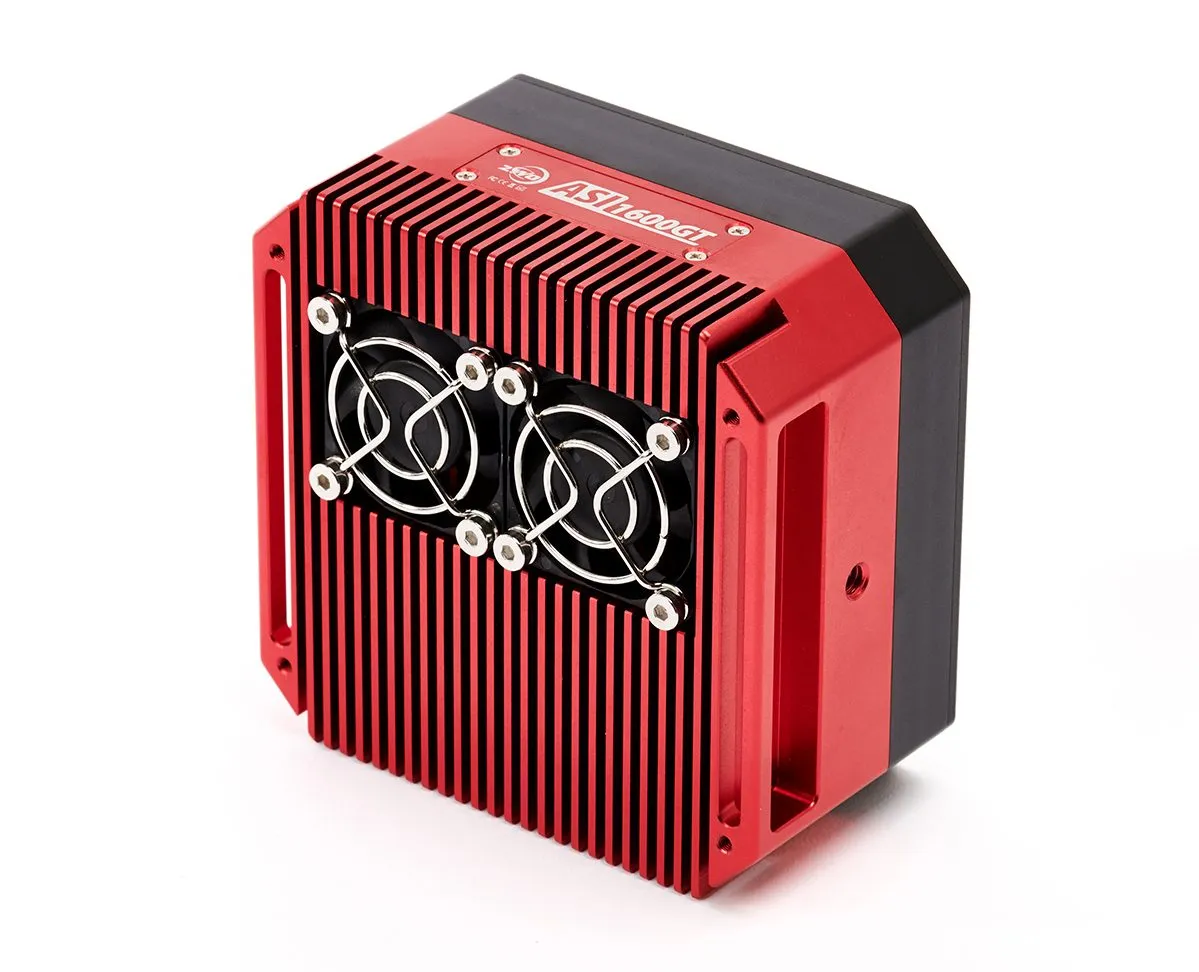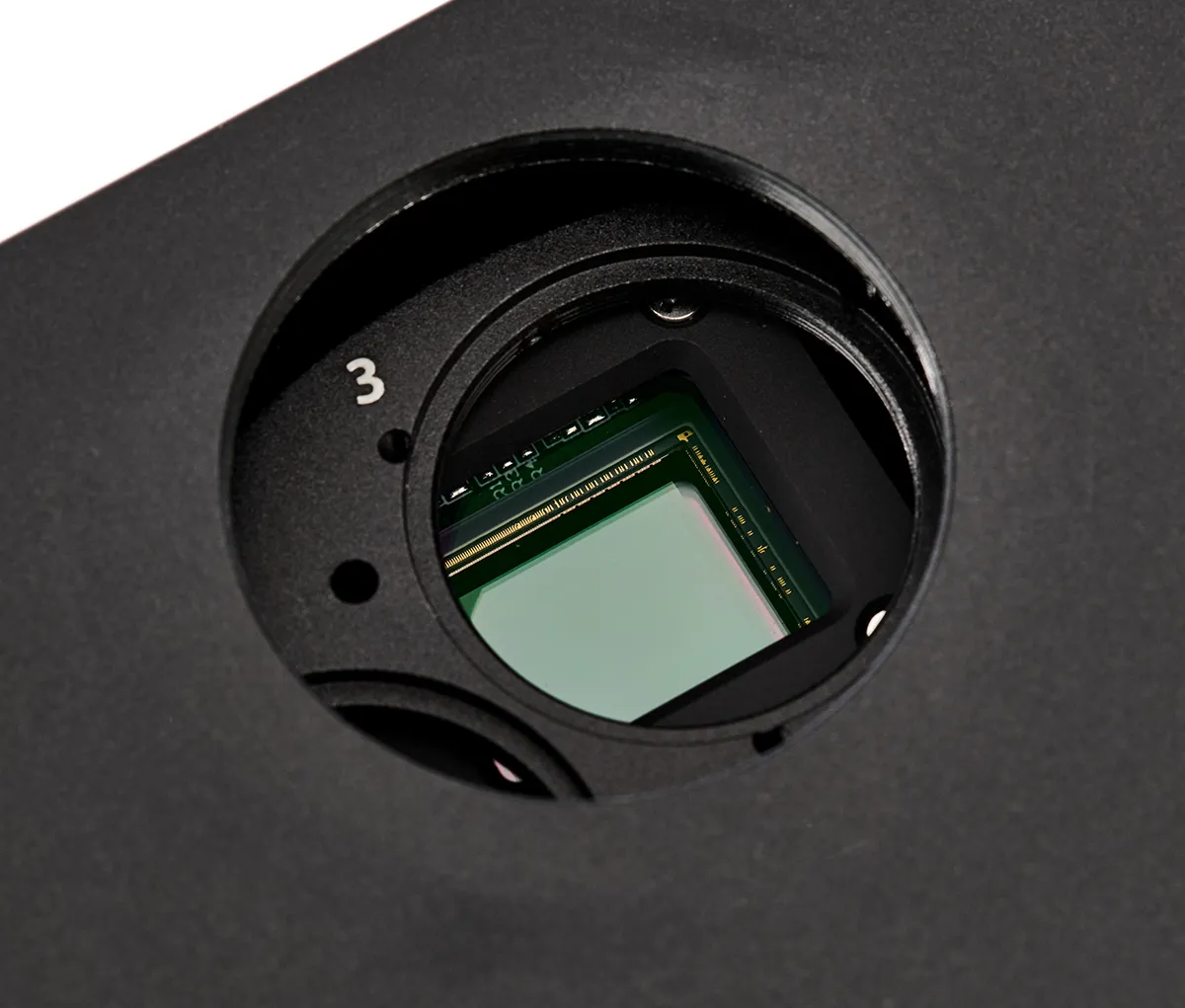ZWO has become a well-established brand in the CMOS camera marketplace: over the last decade it has produced models for all types of imaging. We are used to seeing the cylindrical shape and red colour of its deep-sky cameras, but now ZWO has launched two new ‘GT’ models that break with tradition.
Here, we take a look at the ASI 1600GT M, a mono camera with a built-in filter wheel.
After opening the 1600GT M’s box, we were presented with a square-shaped camera. It’s quite a bit larger than a normal ZWO model – with a stylish heatsink back case, two cooling fans and two handles – and finished in anodised red.
On the bottom we found a USB 3.0 and two USB 2.0 sockets, plus a ‘power in’ socket and a new ‘power out’ socket that can carry 12V to other devices.
This camera is on our list of the best cameras for astrophotography.

There is also a red LED power light for when the camera is active, although this has been reduced in size and isn’t as bright as on other cameras.
The front cover of the camera is black and has four screws. Unscrewing these reveals a filter wheel for 1.25-inch filters with space for five.
Some care must be taken when installing filters as ZWO is quite specific about the size of thread on these, so it’s worth checking the ZWO ASI website before installing them. If they are too big the filter wheel could get damaged before you even start imaging.
You will also need to visit the website to download the drivers for the camera and the ASCOM driver for the filter wheel (ASCOM is an industry-standard interface that allows different pieces of astronomical equipment to communicate), as these are no longer included on software discs.

If you are installing the drivers on a PC, you will also need to have the ASCOM Platform installed there; this will enable you to name the filters and control the filter wheel with software.
The 1600GT mono sensor is a 4/3-inch type with a resolution of 4,646 x 3,520 pixels, while the camera itself has a 256MB DDR3 memory buffer to help with download times.
Setting the camera up for imaging is quite straightforward as the adaptors that give 55mm back focus are included in the box.
For the first time in a while we had just two hours of clear sky in a whole month. Luckily, we were able to extend our time with the camera. If we hadn’t this review might have been rather short!
One of our main concerns was to see if there would be any vignetting. This is when the brightness of an image falls away towards the edge of the frame, an aberration which can be caused by small filters being used in conjunction with a large sensor.

In order to test this we set the camera up on a scope which delivered a wider field of view. M42 in Orion was the first target. We tried fairly short exposures and a low gain as we were using quite a fast imaging system with a focal ratio of f/2.8.
Capturing RGB images and processing them revealed no evidence of vignetting, indeed we had detail right to the edge of the field.
On other targets, including the M81 and M82 galaxy pair and the Cone Nebula, the 1600GT M performed very well and the filter wheel was very fast and smooth in operation.
When we processed the images we were pleased to see lots of crisp detail with very little noise considering the imaging times.
The camera may cost a little over what you would pay for a 1600MM Pro and separate five-position filter wheel, but the 1600GT M has advantages over separate items: there are fewer cables and you can seal the filters inside the camera to stop any problems with dust when not in use.

Having the internal filter wheel also avoids any problems with moisture on the sensor window. It would, however, be nice to see a power supply included.
You’ll need to purchase it separately or use your own and it has to be 5A minimum, bearing in mind that you might be using the ‘power out’ socket for another device.
Overall, we are pleased to report that the camera performed very well and would be good for anyone who is looking for a mono camera that is easy to use.
ZWO ASI 1600GT's Panasonic MN34230 sensor

Integral to the ZWO ASI 1600GT is the Panasonic MN34230 sensor, which has a proven track record for capturing stunning astro images since it was released a few years back.
In the early days it suffered from amp glow and other small issues, but ZWO has done some good work to iron out these problems and make its versions of the sensor very clean, with the result that there is little noise (unwanted artefacts) in the final images.
The sensor is more commonly known as the ASI 1600 and has a lot to offer in terms of its specifications, starting with a resolution of 4,656 x 3,520 pixels and a pixel size of 3.8μm.
There are plenty of custom sizes that can be selected for the camera’s region of interest via your camera control software, so you can get a little ‘closer’ to objects when you are using smaller telescopes.
The camera is also relatively fast for a deep-sky camera at 23fps in full resolution. We found that frame rate increased as we reduced the size of the region of interest, making it very good for lunar and solar imaging – another bonus considering the 1600 GT M is billed as a deep-sky camera.
Cooling system
The rear casing has a heatsink cover with 24 grooves and two maglev fans for additional cooling. Together they allow the camera to cool to 40°C below ambient temperature. This is all easy to control in your favourite capture software and helps to reduce the noise, or unwanted artefacts, in the captured images.
Internal filter wheel
The built-in filter wheel – driven by a silent stepper motor – ticks the box for being easy to use, and is one less item to install. It has five slots that will take 1.25-inch (31mm) filters, which are easy to install by removing the four screws on the front cover.
USB sockets
On the bottom of the camera is a bank of USB sockets, the blue USB is a high-speed USB 3.0 socket which also doubles as a USB2 socket used to operate the camera. Next to it are two USB 2.0 sockets that are used to plug in accessories.
Power sockets
A new feature with this camera is the ‘power out’ socket. With the option to mount a never-ending list of accessories to use near the camera (for example, an electric focuser or a rotator), more power sockets always come in useful and cut down on the amount of wires running up to the telescope.
Accessories
A batch of accessories are included to connect the camera to different equipment. The two extenders give a combined back focus of 55mm for pairing with focal reducers. There’s also a screwdriver for removing the main cover, plus extra cables and filter masks with screws.
Vital stats
- Price £1,785
- Sensor Panasonic MN34230
- Image format 4,656 x 3,520 pixels
- Pixel size 3.8µm
- Full resolution 23fps
- Camera size 110mm x 110mm
- Weight 1.10kg
- Extras Cables, an extender and spacer adaptors, filter masks, a screwdriver and screws
- Supplier 365 Astronomy
- Tel 020 3384 5187
- www.365astronomy.com
This review originally appeared in the November 2020 issue of BBC Sky at Night Magazine.